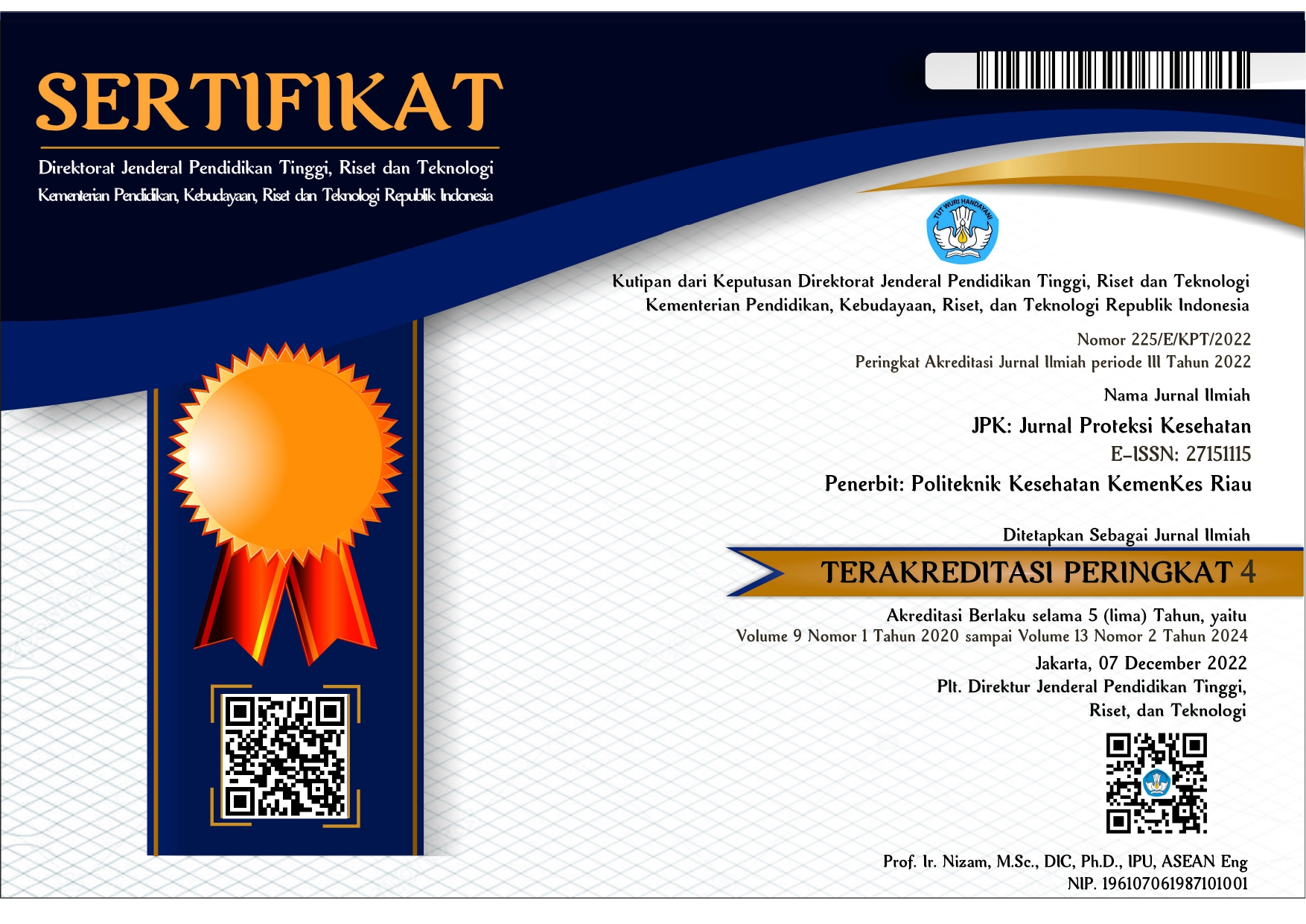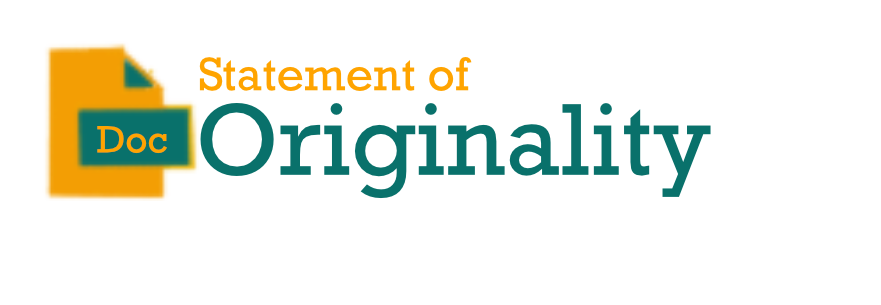Analysis of Pro-Environmental Behavior using the 5R method (Rethink, Reject, Reduce, Reuse, Recycle) towards Waste Management
Abstract
Pro-environmental waste management behavior can help reduce environmental damage or improve environmental conditions. The 5R method is rethink, reject, reduce, reuse, recycle. Preliminary data showed that 74% of the community had low knowledge of 5R, 78% had negative 5R attitudes, 55% had poor 5R actions in waste management. This research aims to determine the analysis of Pro-Environmental Behavior using the 5R method for Waste Management. This type of research is quantitative analytical cross sectional design. The research location is Rukun Tetangga.07/Rukun Warga 01 Perhentian Marpoyan Village. The population and sample are heads of families who live in RT 07/Rukun Warga 01, Perhentian Marpoyan Village, totaling 130 heads of families (Total Sampling). Questionnaire measuring tool. Computerized data processing. Univariate and bivariate data analysis (chi square test) CI 95%. The research results show that there is a relationship between pro-environmental behavior and the 5R method in waste management. Cooperation and integration of various parties, including the community, private sector and government, is needed to overcome this waste management.
References
[2] Fatah, D, “Wow Indonesia Produces 64 Million Tons of Waste per Year”, viewed 2 October 2019. https://indopos.co.id/real/2019/07/07/180601/wow-indonesia-produk-64-juta-ton-sampah-per -year/
[3] SIPSN, “Data on Waste Management Performance Achievements in Regencies/Cities throughout Indonesia in 2022”, 2022
[4] Ernawaty, et al. “Waste Management in Pekanbaru City”, Environmental Dynamics, Vol 6, No 2. Pp. 126-135, 2019, http://dx.doi.org/10.31258/dli.6.2
[5] Hendra, S. Febriana SKT, Akbar SN, “The Influence of Leadership Roles on MAPALA Piranha Members”, Ecopsy Journal, Vol.3, No.3, pp. 155-159, 2016, http://dx.doi.org/10.20527/ecopsy.v3i3.2667
[6] Pekanbaru.go.id, “ DLHK Pekanbaru Places 14 Tank Units to Prevent People from Throwing Waste Carelessly”, 2023
[7] Jambeck, JR, R. Geyer., C. Wilcox., TR Siegler., M. Perryman., A. Andrady., R. Narayan., KL Law, “Plastic Waste Inputs From Land Into The Ocean”, Science, Vol 347, no. 6223, pp. 768-771, 2015, http://dx.doi.org/10.1126/science.1260352
[8] Government Regulation no. 81 of 2012 concerning Management of Household Waste and Similar Household Waste, 2012
[9] Qodriyatun S, N, dkk (2019), Sampah Plastik dan Implikasi Kebijakan Pembatasan Plastik Sekali Pakai Terhadap Industri dan Masyarakat, Cetakan Pertama, Jakarta Pusat, Pusat Penelitian Badan Keahlian DPR RI
[10] Septiana, I., & Rusli. Zaili Elementary School, “Evaluation of the Pekanbaru City Government's Strategy in Defending Adipura in 2014-2015”, Student Online Journal (JOM) in the Field of Social and Political Sciences, Vol 3, no. 2, pp. 1–14, 2016
[11] World Bank, “What a Waste a Global Review of Solid Waste Management”, 2012
[12] Ministry of Environment, “Management of the environment”, Jakarta: Ministry of Environment; 2013
[13] Purba, WS, Safitri, PA, & Andianti, R, “Indonesian Environmental Statistics 2017”, Jakarta: Central Statistics Agency, 2017
[14] Pekanbaru City Central Statistical Agency, “Pekanbaru City in Figures 2017”, Pekanbaru. 2017
[15] Riskesdas, “Basic Health Research”, 2018
[16] Suyanto, “Data Mining for Data Classification and Clustering”, Bandung: Informatics. 2017
[17] Hasri, Deta Amelia, Surahma Asti Mulasari, Subardjo, Sulisyawati, Tri Wahyuni Sukesi, Ichtiarini Nurullita Santri, “The Relationship between Students' Knowledge Level and Waste Volume on Campus V Ahmad Dahlan University Yogyakarta”, Journal of Health and Environmental Management, Vol 3, No. 2, pp. 37-44, 2022, http://journal2.uad.ac.id/index.php/jkpl/index
[18] Ernawaty, et al, “Waste Management in Pekanbaru City”, Environmental Dynamics. Vol 6, No 2. 2019, http://dx.doi.org/10.31258/dli.6.2.p.126-135
[19] Khaidir, “Integrated Environmental Based Waste Management Model at Muara Fajar Landfill, Pekanbaru City” , Riau University Environmental Science Doctoral Program. 2021
[20] Rosmawati, Ria Damayanti, Elvi Juliyansyah, “The Relationship between Knowledge, Attitudes and Availability of Facilities with Household Waste Management in Kapuas Kanan Hilir Subdistrict”, Public Health Scientific Journal Vol. 1, No. 1, 2022
[21] Irawati, et al, “Factors Related to People's Behavior in Disposing of Household Waste in the Viktori Canal, Sorong City”, Journal of Health Research FORIKES VOICE Vol. 12,No. 3,pp 2021.
[22] Rosmawati, et al, “The Relationship between Knowledge, Attitudes and Availability of Facilities and Household Waste Management in Kapuas Kanan Hilir Subdistrict”, Public Health Scientific Journal, Vol. 1, No. 1, Pp. 1-12. 2022
[23] Notoadmodjo, “Health Behavior Science” Jakarta: PT. Rineka Cipta. 2012
[24] Sapci, O., & Considine, T, “Journal of Behavioral and Experimental Economics The link between environmental attitudes and energy consumption behavior”, Journal of Behavioral and Experimental Economics, 52 ,pp.29–34, 2014, https://doi.org/10.1016/j.socec.2014.06.001
[25] Khazana, “Analysis of Community Behavior towards RT Waste Management in Padang Baru Village, Susoh District, West Aceh Regency Data” Faculty of Public Health. Thesis Teuku Umar University, 2022
[26] Muliawati, R. et al, “Basic Pillars of Public Health Science”, Yogyakarta: Nuha Medika
[27] Astina, N, et al, “Factors Associated with Community Behavior in Throwing Household Waste into the River in Pamarangan Kanan Village, Tabalong Regency”, 2019. Journal of Medical Technology and Public Health, vol. 4, no. 2, pp.181-190, 2020
[28] Hairil, A, et al, “Aspects of Community Knowledge and Attitudes towards Household Waste Management in Muntoi Village,” Journal of Preventive Promotion. Vol. 3, No. 2, Pp. 22-27, 2021
[29] Syam, DM, “The Relationship between Community Knowledge and Attitudes and Waste Management in Loli Tasiburi Village, Banawan District, Donggala Regency “,HYGIENE: Journal of Environmental Health, Vol 2 No 1 , pp. 21-26, 2016
[30] Rubenfeld, MG et al, “ Critical Thinking in Nursing”. Edition 2, Jakarta : EGC, 2017
[31] Dhea, A, et al, “Factors Influencing Household Waste Handling in Johan Pahlawan District, West Aceh Regency in 2020”, Journal of Public Health, Faculty of Public Health, Teuku Umar University
[32] Despa Wildawati, Hasnita E, “Factors related to community-based household waste management in the Hanasty waste bank area‟, Health Journal, vol. 4, no. 3, pp. 149–158, 2019, http://dx.doi.org/10.32883/hcj.v4i3.503
[33] Ranno, MR, et al, “Factors Related to Household Waste Management in Senua Village, Kendari City in 2018”, Scientific Journal Of Civil Engineering vol. 8, no. 1, pp. 3-14, 2020, http://dx.doi.org/10.55679/jts.v8i1.12673
[34] Siswati, L., Eterudin, H., Setiawan, D., Ratnaningsih, A. T., & Yandra, A. “Penyadaran Kepada Ibu Rumah Tangga dalam Pemisahan Sampah Organik dan Anorganik Rumah Tangga di Kecamatan Minas”, Diklat Review: Jurnal manajemen pendidikan dan pelatihan, 6(1), 94-101,2022.












